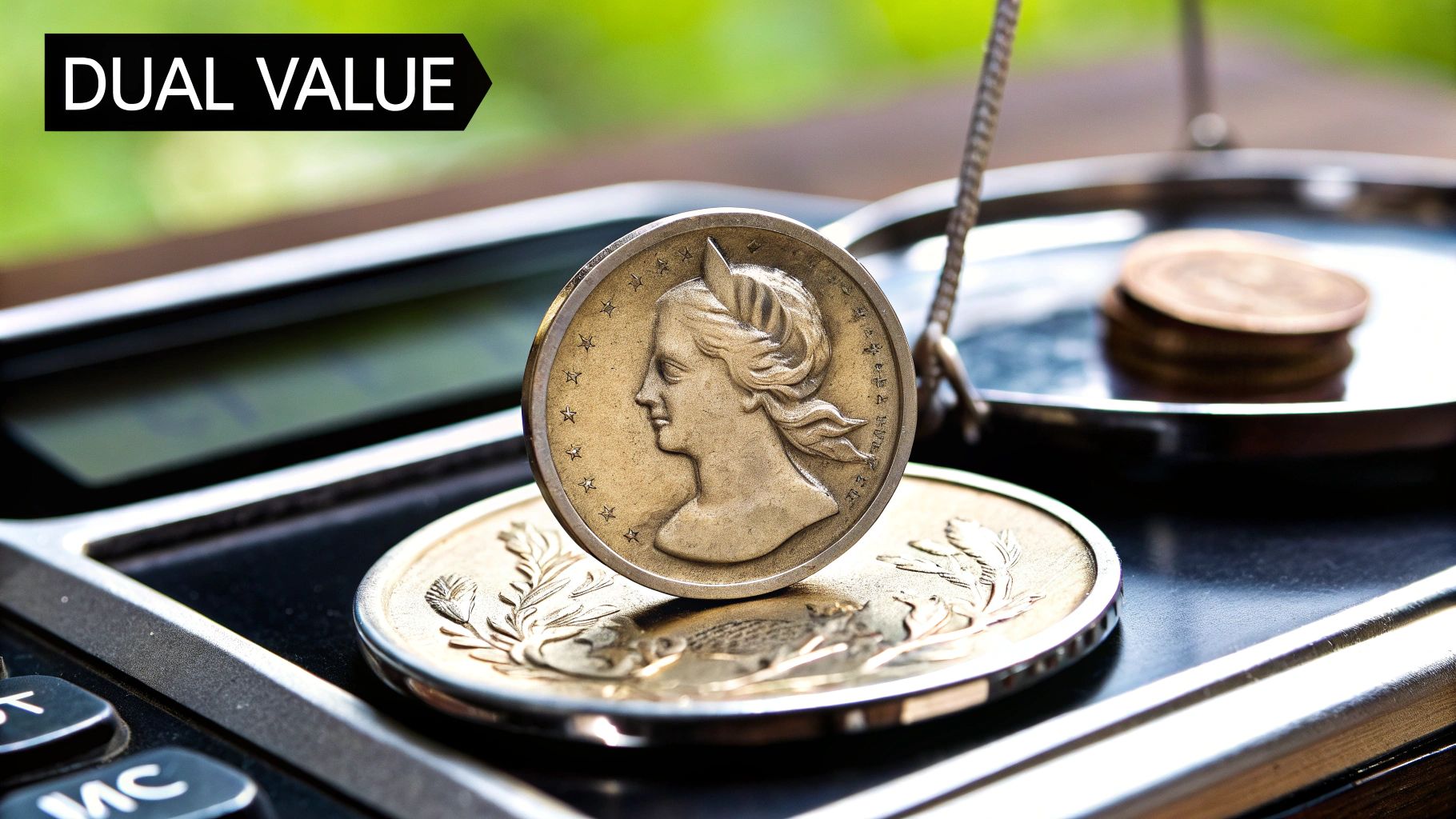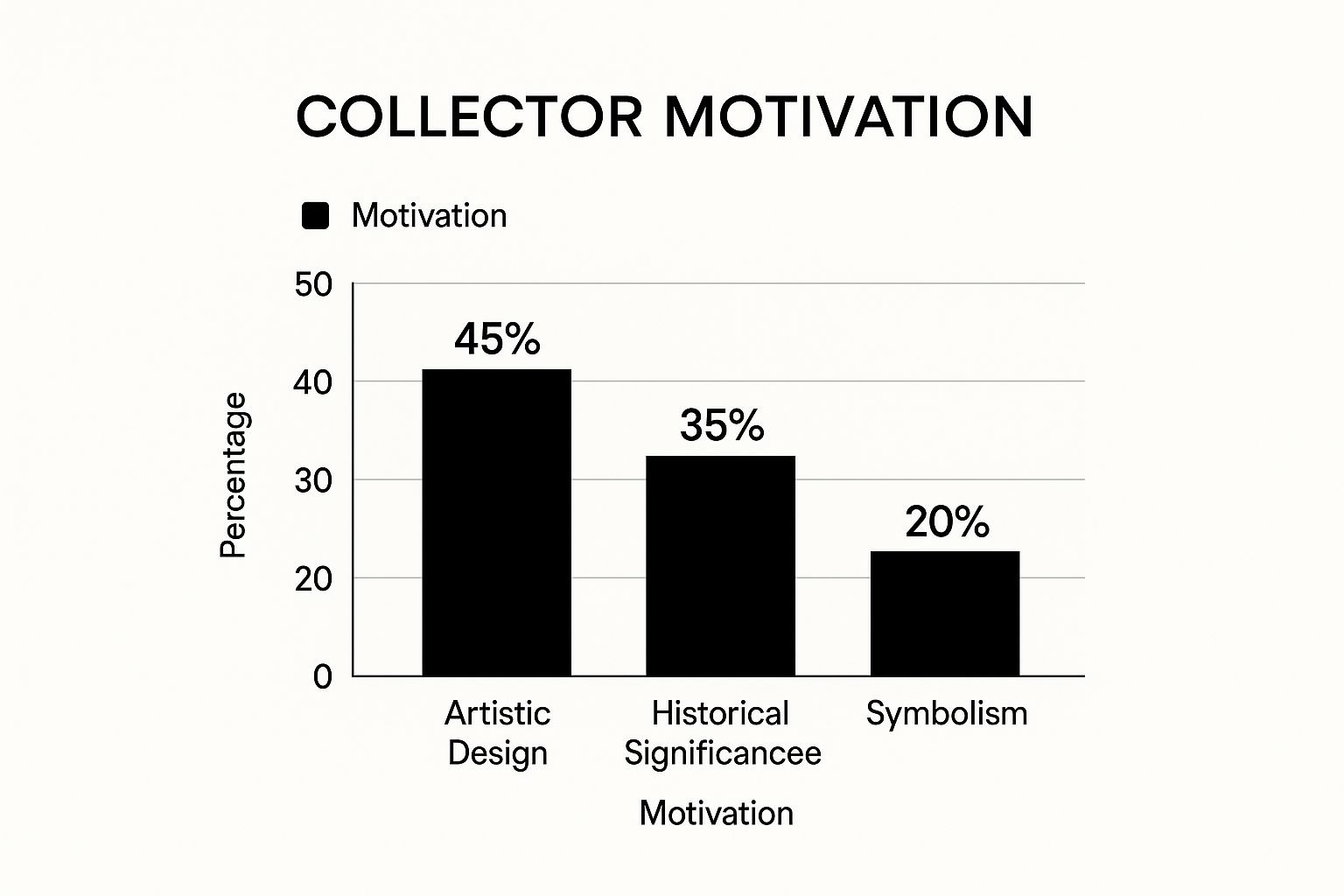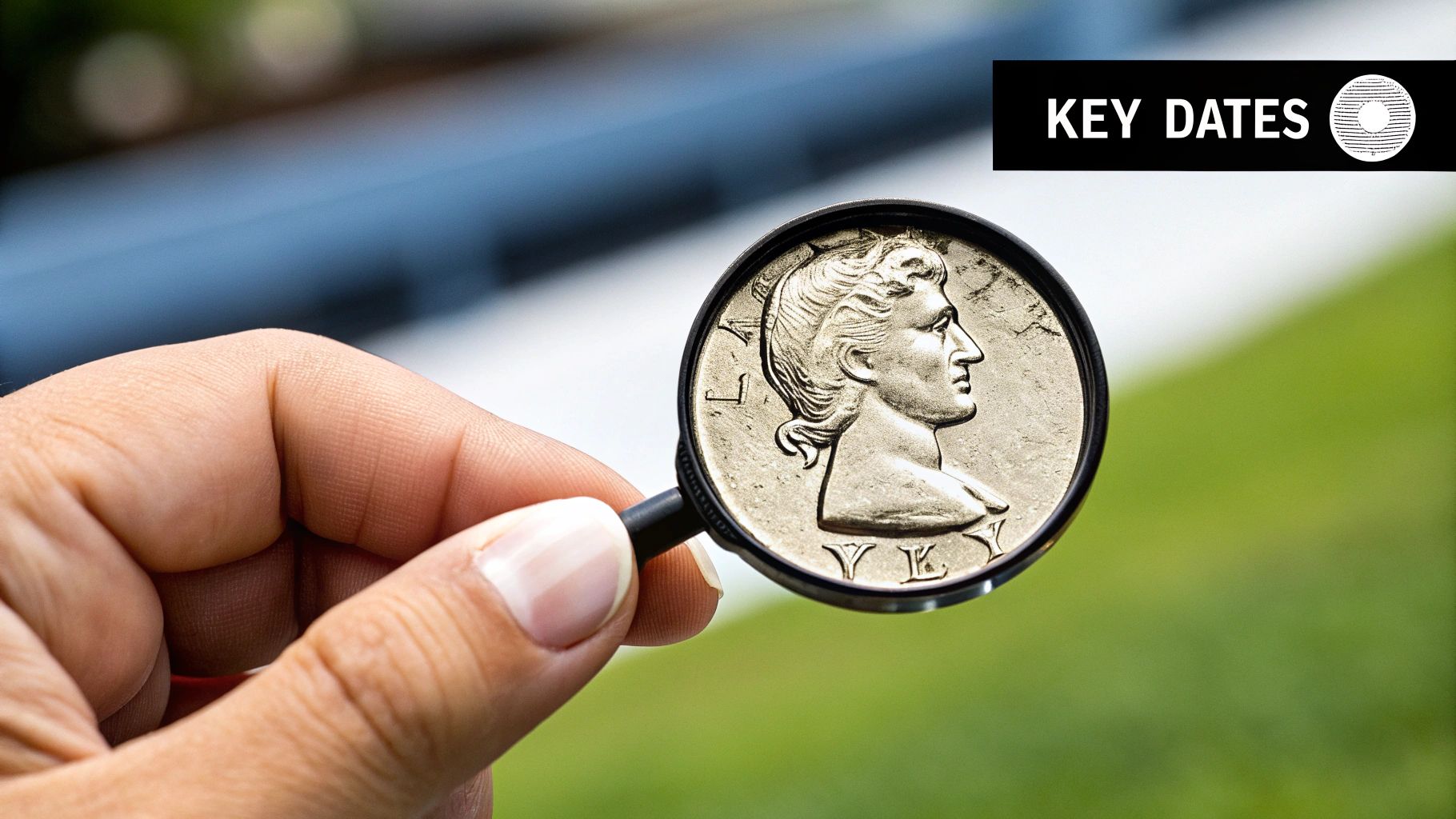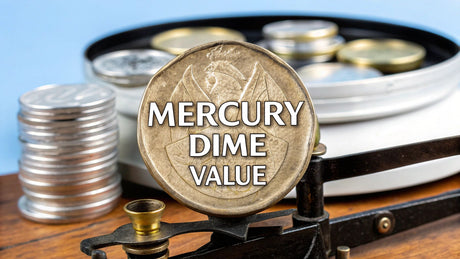When you're trying to figure out what a Mercury dime is worth, you're really looking at two separate things: its 90% silver content and its value as a collectible coin. The silver gives it a solid baseline price, but the real magic—and potential for high value—comes from its rarity, date, mint mark, and overall condition.
The Two Values of Every Mercury Dime

Every Mercury dime has a dual identity. In one sense, it's a small, tangible piece of a precious metal. In another, it's a tiny artifact from American history. Getting a handle on this duality is the first step to knowing what your coin is really worth.
Think of it like a classic car. It has a scrap metal value—the absolute minimum you'd get if you just melted it down. But nobody does that, because its true value is in its make, model, year, and how well it's been preserved. A pristine classic is worth far more than the sum of its parts, and the exact same principle applies to your Mercury dimes.
To make this crystal clear, let's break down how these two value components work together.
Mercury Dime Value At a Glance
| Value Component | What It Means | Typical Value Range |
|---|---|---|
| Silver "Melt" Value | The base value of the 90% silver inside the coin. This is the price floor. | $1.50 - $3.00+ (changes with the silver market) |
| Common Numismatic Value | The value for a common-date, circulated coin sold to a collector. | $2.50 - $5.00 |
| Key Date Numismatic Value | The premium for rare years and mint marks, even in worn condition. | $10 - $1,000+ |
| High-Grade Premium | The added value for a coin in pristine, uncirculated condition. | $20 - $100,000+ |
This table shows how a dime can go from being worth a couple of bucks to becoming a serious investment, all based on the factors we'll explore.
The Silver Safety Net
The most basic part of your dime’s value comes from its silver. Minted from 1916 to 1945, these coins are made of 90% silver, which gives them an intrinsic "melt value." This value acts as a price floor; no matter how worn down it is, your coin will always be worth at least its weight in silver.
This silver content is the main reason so many pre-1965 coins are pulled from circulation. You can learn more about why that year is so important by discovering treasure and identifying valuable coins from 1964 and earlier. This silver foundation guarantees your coin is always worth more than just ten cents.
The Collector's Premium
Here’s where things get exciting. The second source of value is its numismatic, or collector, appeal. This is how a dime worth a couple of dollars in silver can suddenly be worth hundreds or even thousands. Several factors create this premium:
- Rarity: This is all about the year it was minted and the mint mark that shows where it was made. Some combinations are incredibly scarce.
- Condition: A shiny, uncirculated coin with sharp details is worlds apart from a smooth, worn-down one in terms of value.
- Errors: Sometimes the minting process goes wrong, creating unique and highly sought-after error coins.
This collector premium is what separates a common silver coin from a true numismatic treasure. While the silver provides a safety net, the story, scarcity, and preservation of the coin are what create significant financial worth.
Whether you have one interesting dime or an entire collection, understanding both sides of its value is key. When you're ready to sell, you can skip the hassle and uncertainty of mailing your items away by working with a local expert. Here in Boise, we provide the highest payout and use professional tools like Xray Scanning to give you a transparent, accurate appraisal. Our hassle-free offers and Price Matching guarantee you get the best possible value.
Understanding Your Coin's Silver Melt Value
Before we get into rare dates or mint marks, let's start with the foundation of every Mercury dime's worth: its silver. Every single one of these coins is made of 90% silver and 10% copper, containing precisely 0.0723 troy ounces of pure silver.
Think of this as the concrete foundation of a house—it’s the solid, intrinsic value that everything else is built upon. This is often called the "melt value" or "bullion value," and it's the absolute minimum your coin is worth, tied directly to the live price of silver on the global market. It’s why even a heavily worn, common-date Mercury dime is always worth much more than ten cents.
How to Calculate Your Dime's Melt Value
Figuring out this baseline value is surprisingly simple. You just need one piece of information: the current price of silver, also known as the "spot price."
The math is straightforward:
Current Silver Spot Price per Ounce x 0.0723 = Your Mercury Dime's Melt Value
So, if the spot price of silver is $30 per troy ounce, the melt value of one Mercury dime would be $30 x 0.0723 = $2.17. This number changes constantly with the market, sometimes minute by minute.
To stay on top of it, you can always check the live spot price for gold and silver for an accurate, up-to-the-minute valuation. Knowing this number gives you the starting point for understanding what any Mercury dime in your possession is worth.
More Than Just "Junk Silver"
You might hear bags of common-date, circulated Mercury dimes referred to as "junk silver." The term can be misleading—it doesn't mean the coins are trash. It just means they're being traded primarily for their silver content, not for any special collector traits.
But stopping there can be a huge missed opportunity.
Melting down a coin erases its history, its rarity, and its potential for numismatic value forever. It's the equivalent of scrapping a classic car for its metal—you get a payout, but you might be destroying something far more valuable in the process.
Before you ever think about selling your dimes just for their silver weight, it's absolutely crucial to check for key dates, mint marks, and superior conditions. The collector value, which we'll dive into next, can take a coin's worth from a couple of dollars to hundreds or even thousands.
This is exactly why getting a professional evaluation matters. Here in Boise, we provide Xray Scanning and Gold Testing for free for coins and jewelry. We give hassle-free offers and will match prices to ensure you get the highest payout, helping you see the full story behind your coin's value. You can save the hassle and sell locally for more than online shipments, getting paid what your items are truly worth.
The Story Behind the Coin's Collector Appeal
Why would a collector pay $50, $100, or even more for a simple ten-cent coin? The answer has very little to do with its silver content and everything to do with its story. While the melt value gives a coin a price floor, it’s the numismatic appeal—the artistry, history, and symbolism packed into this tiny metal disc—that truly determines how high its value can climb.
These coins are more than just old currency; they're miniature works of art from a pivotal time in American history. To really get their appeal, you have to appreciate the story they tell, one that started with a desire for a fresh, inspiring design for the nation's coinage.
A New Vision for American Coinage
In the early 20th century, there was a real push to move on from the stuffy, dated coin designs of the past. The Mercury dime, designed by the celebrated sculptor Adolph Weinman and minted from 1916 to 1945, was a breath of fresh air. It replaced the dime designed by Chief Engraver Charles E. Barber, which had been in circulation for 25 years.
This new design was an immediate hit. It captured the national spirit with a beauty and grace that previous coins just didn't have, making it a favorite that collectors still seek out today.
Unpacking the Rich Symbolism
Funnily enough, the name "Mercury dime" is actually a misnomer. The figure on the front isn't the Roman messenger god Mercury. It's Lady Liberty wearing a Phrygian cap, a classic symbol of freedom. Weinman added the wings to her cap to symbolize something powerful and ahead of its time: freedom of thought.
The symbolism continues on the reverse, where two distinct elements come together:
- The Fasces: An ancient Roman symbol of a bundle of rods bound around an ax, representing strength, authority, and unity.
- The Olive Branch: Wrapped around the fasces, this is a universal symbol of peace.
Together, these images send a message of strength through unity, but with a readiness for peace. This rich symbolism elevates the coin from a simple piece of money to a historical statement, which is a huge driver of its collector appeal. These are the kinds of details that get coin collectors excited.

As you can see, the coin's beautiful and iconic design is the number one reason collectors are so drawn to the series.
From Pocket Change to Cherished Collectible
It's this combination of Weinman’s fantastic artistry and the coin's deep historical context that fuels collector demand. For many, completing a full set of Mercury dimes is a rewarding journey through a fascinating period of American history. If that sounds interesting to you, our guide on how to start your coin collecting hobby has some great practical tips to get you going. This passion is exactly why people are willing to pay significant premiums for well-preserved examples.
When you hold a Mercury dime, you're not just holding silver; you're holding a piece of early 20th-century American identity. This tangible connection to the past is what transforms a simple coin into a prized possession.
Understanding this collector appeal is vital when you're thinking about selling your coins. It’s the difference between getting a few dollars for scrap silver and realizing their much higher numismatic value. Here in Boise, we appreciate the stories behind your treasures. We offer the highest payout in Boise for Gold and Jewelry Buying, making sure you get a fair price based on both the metal content and the collector value. With our Xray Scanning for free and Price Matching, you can save the hassle and sell locally for more than online shipments. We provide hassle-free offers so you know you're getting the best possible price.
How Key Dates and Mint Marks Create Rarity

While every single Mercury dime has that solid silver floor to its value, this is where things get really interesting. We’re about to uncover the single biggest factor that separates a common coin from a true collector's prize: rarity.
In the world of coin collecting, rarity is king. It’s simple supply and demand. When millions of a certain coin were made, they're easy to find. But when only a small batch was produced? Collectors will line up and pay a premium to own one.
This scarcity all comes down to two tiny details stamped on the coin: its date and its mint mark. The date tells you when it was made, and the mint mark tells you where. Together, these two clues can turn an ordinary dime into a legendary treasure.
Finding and Understanding Mint Marks
So, where do you look for this all-important clue? Grab your dime and flip it over to the reverse side—the one with the fasces (the bundle of rods). Look closely near the bottom, just to the left of the olive branch's base. You’re looking for a tiny letter.
You'll find one of three things:
- No mint mark: This means your dime was struck at the main U.S. Mint in Philadelphia. This was the default, so no mark was needed.
- A "D" mint mark: This little letter means the coin came from the Denver Mint.
- An "S" mint mark: This signifies it was produced at the San Francisco Mint.
This is huge. A 1925 dime with a "D" is a completely different animal to a collector than a 1925 dime with an "S" or no mint mark at all. Each mint had different production numbers every year, creating unique levels of scarcity. Think of the mint mark as the key that unlocks the true story—and potential value—of your coin.
The King of Mercury Dimes: The 1916-D
Every coin series has its icon, the one coin that stands head and shoulders above the rest in both rarity and value. For Mercury dimes, that undisputed champion is the 1916-D.
With a mintage of just 264,000, it is the holy grail for collectors. To give you some perspective, the Philadelphia mint churned out over 22 million dimes that very same year. The Denver mint's tiny production run makes the 1916-D incredibly scarce and, as a result, wildly valuable, no matter its condition.
Its status as the ultimate "key date" sends its price into the stratosphere. A 1916-D in circulated, well-worn condition can still be worth hundreds of dollars, while a pristine, uncirculated example can easily command prices well over $10,000 and sometimes much, much more.
Other Valuable Dates and Error Coins
While the 1916-D is the star of the show, it’s not the only valuable coin in the series. Several other "semi-key dates" and fascinating error coins are highly sought after by collectors. These coins had much lower mintages than their common counterparts, giving them a significant price bump.
One of the most famous errors to hunt for is the 1942/41 overdate. This happened when a die from 1941 was accidentally re-punched with a 1942 date, leaving a faint "1" peeking out from under the "2". It's a rare and prized mistake. If you're interested in other dimes from this era, you can compare values by checking out our guide on the 1912 dime's value.
Key Date Mercury Dimes and Estimated Values
Here’s a quick-reference table to help you spot some of the most valuable Mercury dimes. Keep in mind that these values are estimates and can change based on the coin's specific grade and the current market.
| Year and Mint Mark | Mintage | Approximate Value (Good) | Approximate Value (Uncirculated) |
|---|---|---|---|
| 1916-D | 264,000 | $800+ | $15,000+ |
| 1921 | 1,230,000 | $60+ | $1,500+ |
| 1921-D | 1,080,000 | $70+ | $2,000+ |
| 1926-S | 1,520,000 | $15+ | $1,000+ |
| 1942/41 (Error) | Unknown | $450+ | $5,000+ |
| 1942/41-D (Error) | Unknown | $750+ | $15,000+ |
As you can see, a tiny detail can make a massive difference. Always, always check the date and mint mark. You never know when you might have a treasure sitting in your coin jar.
How Coin Condition Dramatically Affects Value
In the world of coin collecting, condition isn't just a detail—it's everything. A common Mercury dime in pristine, mint condition can easily be worth far more than a rare date that's been worn down from years of circulation. This one factor can swing the value of a dime from a few dollars to thousands, so it's a concept you absolutely need to grasp.
Here’s an easy way to think about it: a circulated Mercury dime is like a reliable, well-loved old pickup truck. It’s done its job, shows the dings and scratches of a long journey, but still holds solid, practical value. An uncirculated dime, on the other hand, is like a classic car that was sealed in a garage the day it was made—untouched, perfect, and immensely valuable to a collector.
The difference in value is staggering. A coin that has passed through countless hands will have its fine details worn smooth, while one preserved since the day it was minted retains every sharp line and subtle texture the artist intended.
From Good to Uncirculated: A Simple Grading Guide
Coin grading is the formal system for describing a coin's condition, but you don't need to be a professional to understand the basics. The grades simply describe how much wear a coin has, from nearly featureless to absolutely perfect.
Here’s a simplified breakdown of the most common grades you'll run into:
- Good (G): The design is heavily worn, with major details smoothed out. You can still make out the date and lettering, but they're faint.
- Fine (F): Most of the major design elements are clear, but you can see significant wear across the entire coin.
- Extremely Fine (EF): This coin shows only light wear, and only on the highest points of the design. You'll still see sharp details in Liberty’s hair and the feathers on her wing.
- Uncirculated (MS): This coin has zero signs of wear. It looks just as it did the day it left the mint, with its original shine and razor-sharp details.
A coin’s grade is the main driver of its numismatic premium. For instance, a common 1944 Mercury dime might be worth $2.50 in Good condition, but that same coin could jump to $20 or more in a high Uncirculated grade. A word of caution: never try to improve a coin's appearance yourself. Cleaning a coin can severely damage its surface and destroy its value. You can learn more about the risks by reading our guide on how to clean a silver dollar.
The Million-Dollar Detail: Full Bands
When it comes to Mercury dimes, there's one specific detail that collectors pay a huge premium for: the bands on the fasces. Flip the coin over and look closely at the bundle of rods on the reverse. You'll see three horizontal bands holding them together.
On most dimes that have seen any circulation, the central lines dividing these bands are the first things to wear away. But on a perfectly struck and preserved coin, these lines are fully separated and distinct. This coveted detail is known as "Full Bands" (FB).
The Full Bands designation is a mark of exceptional quality. It certifies that the coin is not only uncirculated but also features a strong, complete strike right from the mint. This tiny detail can multiply a coin's value, turning a five-dollar coin into a five-hundred-dollar prize.
This distinction is absolutely critical when you're trying to figure out what your collection is worth. While a staggering 2.6 billion Mercury dimes were minted in total, their values today are all over the map. Common circulated dimes might be worth a few dollars, but rarities like the 1942/41 overdate can fetch upwards of $450 in top condition. Dealers base their pricing on condition and rarity, with documented values ranging from under $5 for worn coins to an incredible $240,000 for the rarest, highest-grade specimens.
When you're ready to sell, understanding these nuances ensures you get a fair price. Here in Boise, we offer the highest payout for your gold, jewelry, and coins. We provide Xray Scanning and Gold Testing for free with hassle-free offers. Save the hassle and sell locally for more than online shipments—we even offer Price Matching to guarantee you get the best deal.
Getting the Highest Payout for Your Coins in Boise
You’ve done the hard work. You've learned about the silver content, the history, the key dates, and how to judge the condition of your Mercury dimes. Now you have a good idea of what they might be worth. But there's one last, crucial step: finding the right place to sell them.
It's tempting to use online marketplaces or those mail-in services you see advertised. They seem easy, right? The problem is, they're often a gamble. You're dealing with shipping hassles, hidden fees, and the risk of getting a final check that’s far less than you expected.
The smartest move? Save the hassle and sell locally for more than online shipments. Nothing beats a direct, in-person transaction with a trusted expert. It takes all the guesswork out of the process—no more shipping valuable coins into the void and hoping for the best.
Why Selling Locally is the Smarter Choice
Choosing a local gold and jewelry buyer here in Boise gives you an edge that online sellers just can't offer. When you come in, you're part of the process. You can watch the evaluation, ask questions, and get a firm, immediate offer.
This isn't about being just another tracking number in a huge system. A reputable local buyer has a reputation to uphold in the community. We're motivated to give you a fair, transparent, and positive experience because our business depends on it.
Selling your valuables shouldn't feel like a leap of faith. A local expert gives you the security of a face-to-face transaction, the confidence of a professional appraisal, and the satisfaction of walking out with the highest possible payout, right on the spot.
The Power of Professional, Free Appraisals
How can you be absolutely sure you’re getting what your coins are truly worth? It all comes down to an expert evaluation using the right technology. That's why we offer Xray Scanning and Gold Testing for free for all coins and jewelry.
This is a completely non-invasive, scientific process that precisely determines the metal content of your items without a single scratch. It’s about getting you a number based on hard data, not just a quick eyeball estimate.
We’re committed to giving you the highest payout in Boise, and we stand by that promise. Here’s how:
- Hassle-Free Offers: Our appraisals are always free, and you're never obligated to sell. We want you to feel informed and confident, not pressured into a decision.
- Price Matching: We're so confident in our offers that if you get a better written offer from a local competitor, we'll match it.
When you work with a trusted local expert for Gold and Jewelry Buying, you’re getting more than just cash for your coins—you’re getting peace of mind. You sidestep all the risks of selling online, get the benefit of professional technology, and leave with immediate payment, knowing you got the best price for your treasured coins.
Your Top Mercury Dime Questions Answered
Even after getting the basics down, you're bound to have a few specific questions pop up as you start looking through your Mercury dimes. Think of this as a quick reference guide to tackle some of the most common things people ask, helping you feel more confident in what you've got.
Are All 1940s Mercury Dimes Made of Silver?
Yes, they absolutely are. Every single Mercury dime struck for circulation from its first year in 1916 all the way to its last in 1945 is made of 90% silver.
That means any dime you find from the 1940s has a solid foundation of value based purely on its silver content, which moves up and down with the daily price of silver. The only exception you'll ever see is the 2016 Centennial Gold Mercury Dime, but that was a special collector's issue made of 24-karat gold and was never meant to be spent.
What Is the Rarest Mercury Dime?
The undisputed champion of rarity in the Mercury dime series is the 1916-D. The Denver mint only produced 264,000 of these coins, a tiny fraction of what the other mints churned out that year. This incredible scarcity makes it the ultimate "key date" for the entire collection.
Because of this, the 1916-D is the coin every serious collector dreams of finding. It commands a huge price, even if it's in pretty rough, heavily circulated condition.
How Can I Tell If My Dime Has Full Bands?
This is where you'll need a good magnifying glass. Flip the coin over to the reverse side and zero in on the fasces—that bundle of rods in the middle. You're looking for the three horizontal bands that hold it all together.
A true "Full Bands" (or FB) coin must have clear, complete separation lines running across the two central horizontal bands. These delicate details are the very first thing to wear down in circulation, so finding a coin with sharp, distinct bands is a sure sign it's a well-preserved, uncirculated piece worth a serious premium.
Figuring out the full story and value of your Mercury dimes takes a keen eye and a bit of expert knowledge. When you decide it's time to sell, you can save the hassle and sell locally for more than online shipments. Our Gold and Jewelry Buying services in Boise give you the security and transparency you deserve.
We offer Xray Scanning and Gold Testing for free to accurately see what you have, ensuring you get the highest payout in Boise. With our hassle-free offers and a Price Matching guarantee, you can walk away confident you received the best possible value for your items.
Ready to discover the true value of your coins and jewelry? Visit Carat 24 - Trusted Gold Experts today for a free, no-obligation appraisal. Learn more and plan your visit at https://carat24boise.com.


